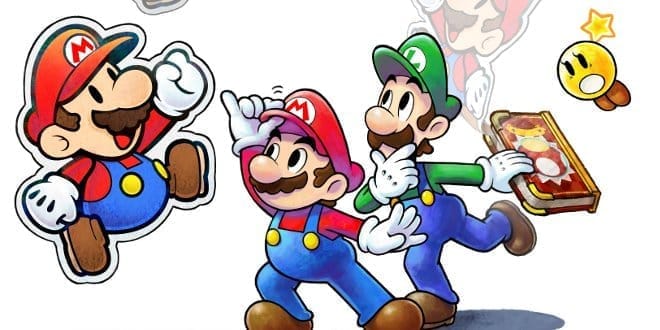Mario & Luigi: Paper Jam was never going to live up to the lofty expectations that a Mario & Luigi RPG/Paper Mario crossover would bring to the table. Ever since the muddled reception to both series' previous entries (Sticker Star and Dream Team respectively), there was a lot of hope resting on the crossover to supply some of that creativity that the last two entries in each series lacked. Unfortunately for anyone that was hoping for the sort of creative characters and storytelling that both series' were known for, Paper Jam isn't that type of Mario RPG. Instead, it focuses on examining exactly what makes an RPG a "Mario RPG" in the first place, and the game has a lot of fun meshing ideas between the two premiere Mario RPG franchises, even if the result might not be what fans were exactly expecting.
The first thing that should be noted about Paper Jam is the fact that it isn't a true crossover. At its core, the title is a Mario & Luigi game that includes Paper versions of classic Mario characters and villains. Although the addition of Paper Mario characters mixes up the combat to a certain degree besides aesthetic, Paper Jam doesn't borrow much from the "Paper Mario" side of its equation. An argument can be made that the title doesn't take much inspiration from its Mario & Luigi half either, as the game world follows the now clichéd Grass World, Desert World, Beach World, Forest World, Ice World, Mario progression. At first glance, it would seem like Paper Jam is obsessed with keeping things "safe", as to not deviate from the "Mario formula" too much. Thankfully, those assumptions would be wrong!
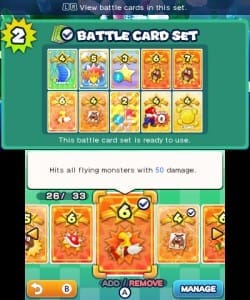
Mario & Luigi: Paper Jam starts off with a simple enough premise. While looking for a hole in the castle's wall to patch up, Luigi and a random Toad manage to inadvertently find and open the book containing Paper Mario's world, releasing all the inhabitants and a good deal of the Paper World in the process. One thing leads to another, and both versions of Princess Peach (regular and Paper) get kidnapped by the combined forces of Bowser and Paper Bowser's army while a plethora of Paper Toads are lost and wandering around the world, waiting for the combined effort of Mario, Luigi, and now Paper Mario, to save them. It's not a complicated plot by any means - there are no real twists and turns in the narrative, and the real enjoyment comes from the excellent characterization at play here.
One thing that both the Mario & Luigi series, as well as the Paper Mario series, have always been known for is their excellent characters and a good story dynamic. Although Paper Jam doesn't add any truly "new" characters to the mix this time around, the wordplay between characters is still wholly enjoyable. Although there aren't many laugh-out-loud moments like previous games, the smart writing at play here makes sure that even though the main story isn't all the interesting, it's still enjoyable watching it unfold.
As far as combat, Paper Jam is the same as the last few Mario & Luigi games aside for the addition of Paper Mario as a playable character. His addition ends up changing the game in several different ways. First off, his addition means that there's always one more potential target for enemies to face. In simple combat instances, countering feels all the more dynamic just by his presence, and that's not even most of the depth that he adds to the game. In addition to the standard jump and hammer attacks that the regular Mario and Luigi share, Paper Mario's jump can be held for a little while like a Yoshi's "flutter" jump, and Paper Mario has access to his own exclusive "Copy Block" ability and Trio Attack moves.
Trio Attacks aren't especially different compared to the bog-standard Bros. Attacks besides generally being more than a little more flashy, as well as longer lasting, but Paper Mario's Copy Block ability showcases probably one of the best new additions to the Mario & Luigi RPG's gameplay to date. By default, Paper Mario's health pool is a good deal smaller than the other two characters, leaving him more susceptible to being knocked out. To counter this weakness, Paper Mario gains access to the "Copy" ability. When chosen in battle, this will max out Paper Mario's copies to whatever number is his current max. Whenever Paper Mario has any copies in play, his standard health bar is replaced by a "copy" number bar - indicating how many copies are currently in play.
The more copies that Paper Mario has, the higher the buffer for his health pool, so every time he gets hit by an attack he'll only lose copies, until there's only one Paper Mario left. Whenever there is more than two Paper Mario copies in play, Paper Mario's standard Jump and Hammer attacks will gain a unique attribute. For Jump attacks you can keep the jump combo going for each copy you have in play - for hammer attacks, Paper Mario's copies will spread out (fairly) evenly across multiple enemies, dealing potential damage to more than one of the enemies on the field.
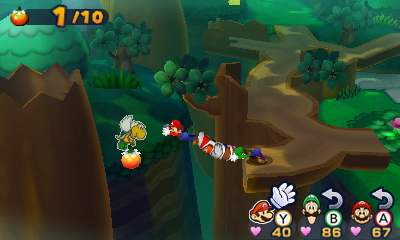
Interestingly enough, it's not only the player that has access to the copy ability in question. Even beyond the one boss fight in the game where the enemy uses your copy block against you, multiple paper enemies throughout the game might be "stacked" multiple layers thick. For "stacked" enemies, an attack that might kill them would only take out one of their copies. Depending on the number of copies that are in their stack, the types and strength of the moves they can use against you change. For the most part, Paper enemies are nearly identical to their regular counterparts, and little details such as stacking and slightly different attack patterns means that even if you've fought a different form of an enemy before, you'll probably still find at least a few things to be surprised by.
The one other new battle mechanic that Paper Jam brings to the table is battle cards. Despite being somewhat similar to the badge system in Dream Team, Battle Cards are much more dynamic, and allow fights to quickly become hectic with buffs, debuffs and attacks being used seemingly every turn. The way that the cards work is by having the player set their own battle card "deck" of 10 cards. These cards have abilities that can be activated in battle, assuming that the player has enough star points to use them. Depending on the strength of the card and whether or not it's a "holofoil" card determines how much each card will "cost" in Star Points. Battle Cards have effects that range from buffing your party's attack power, lowering the enemy's defense, healing a percent of your party's hit points, and more. Every turn you'll have another battle card added to your hand until you max out at 3, and you can "flip over" any card that you don't want to use if you want to continue recycling through your deck.
Some enemies might drop battle cards, and most of the time the cards that they drop will be special ? Cards that can be turned into an Amiibo card. Since I didn't have any compatible Amiibo, I wasn't able to test out this feature. From what a cursory glance of some gameplay has shown, Amiibo cards seem to just be a branded version of regular battle cards that either cost less or might be a bit more powerful than the regular battle card equivalents.
Probably the biggest area where Paper Jam excels is in its boss fights, including the new "Papercraft" minigames. Previous Mario & Luigi games (namely Bowser's Inside Story and Dream Team) featured "Giant Battles" that would take the place of some boss fights, breaking up the gameplay in a way that was different from the rest of the experience. Paper Jam gets rid of these distractions, and instead replaces them with Papercraft Battles. Papercraft Battles take place on a 3D stadium, and play essentially like a giant game of bumper cars with a twist. Every Papercraft you end up using have two basic attacks, a tackle, and a jump. Individual Papercrafts tend to have their own special attributes. For example, the Yoshi Papercraft can use its tongue to lock onto enemies or pull itself across gaps in the floor. There isn't anything especially interesting about these fights, but like the Giant battles before them, they change just enough to be a worthy distraction from the main game.
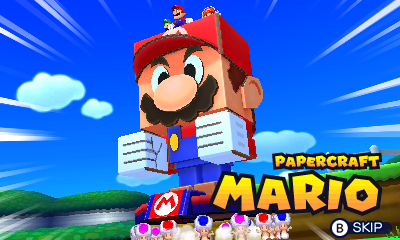
As for regular boss fights, Paper Jam manages to make the vast majority of them feel truly unique. It's hard to go into specifics without spoiling some of the novelty and surprise, but to make matters simple it's hard to think of a boss fight in the game that doesn't have its own unique gimmick. Thankfully, although these gimmicks could've gotten tiring quickly, all of the fights that you face in the title don't overstay their welcome. Bosses in this game take less time to defeat than in previous games, though that doesn't mean that the game is any bit easier than earlier titles in the series. Although bosses have less HP, they tend to dole out more damage. To make matters worse, it almost feels like a lot of these battles were balanced around Battle Cards in the first place.
Probably the last notable change to the combat this time around is in regards to equipment and leveling up. Unlike previous games in the series, you have no additional RNG buffs that you can choose to allot to a character after every level. Instead, you have access to a variety of skills that you can add to your character at the addition of each "Rank-Up". Every few levels your rank improves, which is denoted by such Mario items as a Mushroom, a Green Shell, or what-have-you, and you can choose to give a permanent passive buff to your character. Some of these buffs are specific to each character, such as adding two copies to Paper Mario's max Stack, while others might only be given to one character at a time. It's a fine change, as it makes the party member micromanaging more streamlined and less susceptible to RNG while keeping the inherent strategy at play when building party members intact.
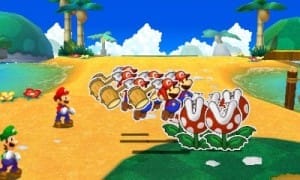
Besides combat, the other portion of the game that Paper Jam really improves over Dream Team would have to be the environments. Not in terms of how unique each of them look (as, again, the title follows the now standard Mario Worlds formula), but by how you traverse them. Unique Trio Abilities can be used on the overworld, opening up a much wider variety of puzzles that can be solved. Perhaps the best part about these new skills is that they all have multiple uses. Not just limited to traversing the environment, but also for uncovering secrets (such as with Trio Hammer being able to break apart rocks or flip certain Paper structures to reveal coins). In that case, although the overworld might seem thematically bland, it's hard to miss that a lot of these environments are interesting to explore, just by how different they are to traverse compared to previous games in the series. One thing that probably helps Paper Jam's case in this regard is the early addition of the "Dash Socks", which allow you to traverse the environment quicker than in any other Mario & Luigi title before, as well as opening up myriad possibilities for side-distractions and Paper Toad minigames.
To sum it up, even though Paper Jam's story might not be as "unique" as some may have hoped, it's hard to ignore how focused the game is in every other regard. The overworld is a joy to explore, battles are more dynamic and interesting than ever, and characters, although limited to classic Mario characters and Starlow, are plenty interesting, with lots of humor and interesting dialogue littered throughout the game. That's not to say anything about the music and/or the art style. The collusion of regular Mario and Paper Mario aesthetics is generally interesting to look at, and the game's soundtrack is fantastic as per usual. Although the game "played things safe" in regards to the narrative, it's obvious that AlphaDream was on top of everything else throughout the games' development. For what it lacks in a "unique" storyline, Paper Jam makes up for in spades, leaving it as the best Mario & Luigi title yet.
Mario & Luigi: Paper Jam was reviewed on Nintendo 3DS with a code provided by the publisher.
Review Summary
For what it lacks in a "unique" storyline, Paper Jam makes up for in spades, leaving it as the best Mario & Luigi title yet.
(Review Policy)Have a tip, or want to point out something we missed? Leave a Comment or e-mail us at tips@techraptor.net
